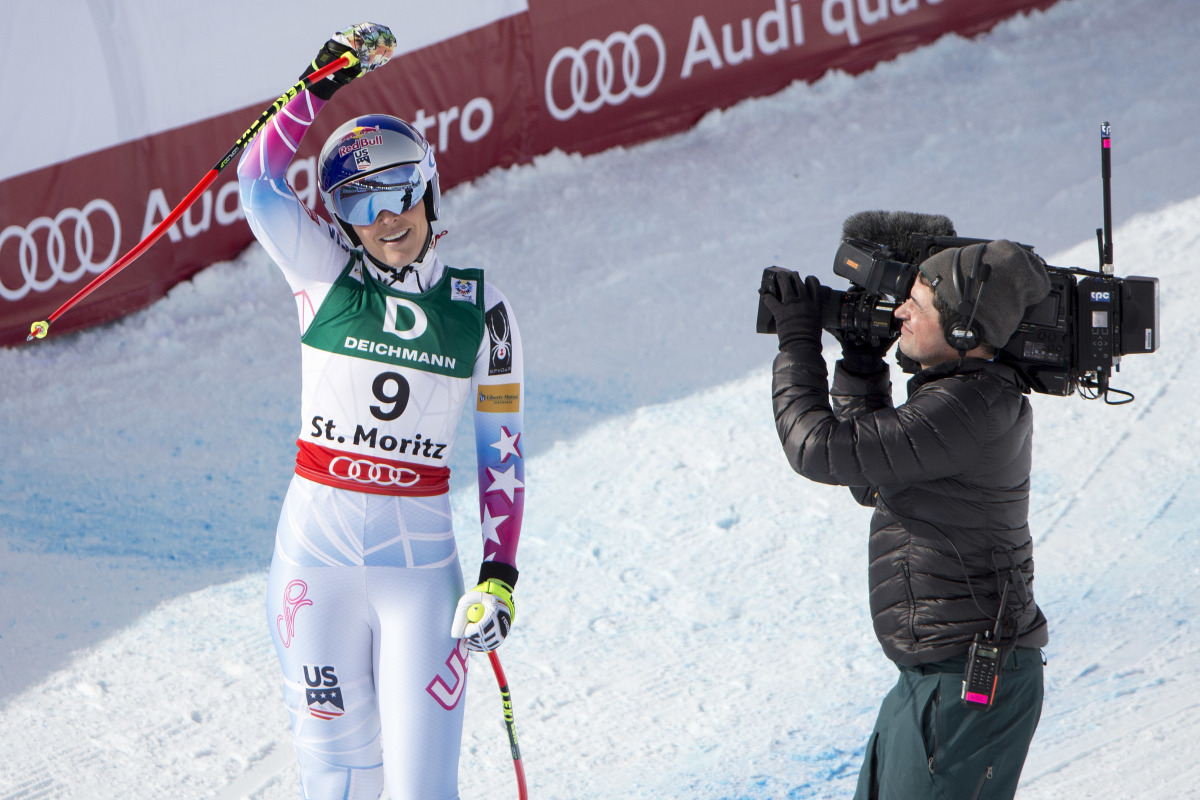NBC Sports Embraces ‘At-Home’ Production for FIS World Alpine Ski Championships
Control room, production team in Stamford, CT, build show from thousands of miles away
Story Highlights
A new remotely controlled production flypack has been deployed for NBC Sports’ coverage of the FIS World Alpine Ski Championships in St. Moritz, Switzerland, and will likely play a key role in future international championship coverage and more. Because much of the actual production is taking place in a control room in Stamford, CT, the system in St. Moritz has allowed NBC Sports to reduce the number of personnel onsite from approximately 40 to 10.

The FIS World Alpine Ski Championships give NBC Sports a chance to make use of a new workflow as it covers skiers like Lindsey Vonn.
“We’re leveraging the trend in technology that makes it so that it doesn’t matter if the [production team] is in the compound or across the Atlantic,” explains Craig Bernstein, director, technical operations, NBC Sports. “If you build it correctly, test it, and have redundancy, the production folks are none the wiser.”
Dubbed NEWBERT, the remote-controlled flypack is modular and scalable. In the case of the FIS Championships, it comprises six flight cases, containing a good-sized Evertz EMR64 router with 64 inputs and outputs. The system fits into only three rack units onsite and is connected to the Evertz Magnum switcher in Stamford. The router panels in Stamford can also control the router in St. Moritz.
“We’ve designed a remote flypack that allows us to do remote mixing in Stamford,” says Craig Bernstein. “One of the big problems has been the latency between the talent onsite and the folks at home, and we put a lot of effort in solving that problem.”
Dominic Torchia, manager, remote technical operations and engineering, NBC Sports, was heavily involved with the design of NEWBERT. He says that, in the case of the Ski Championships, the system takes in dirty feed of course coverage as well as a couple of spits from the start cabin and the finish line. Included in the flypack is a small Blackmagic production switcher, which is remotely controlled by the technical director in Stamford, who in turn passes that signal into a Sony production switcher as a source.
“In Stamford,” says Torchia, “he has a virtual control panel for the Blackmagic so he can preselect any sources in the kit and even do effects through it.”
The flypack also houses a Lawo-based audio core, a small intercom system, and an EVS replay unit. The producer, director, technical director, and replay, graphics, and audio personnel are working at NBC Sports in Stamford and can remotely control the necessary equipment from afar.
“The Lawo commentary system provides the perfect number of resources we need for a show like this,” says Torchia. “It plugs into the Ethernet, and everything is ready to go, and 18 commentary units back home are connected.”
Five JPEG transport streams connect the IBC at St. Moritz to Stamford on two diverse 1-Gbps Ethernet circuits provided by Swisscom through the EBU network. An Evertz IP gateway and a small Cisco router play an important part in making it appear as if the control room is located onsite.
“Latency is about half a second, but most of that is because the signals need to be standards-converted twice,” Torchia explains. “And talent is being mixed locally so they don’t even really know that there is not a production truck onsite.”
The A1 audio mixer also operates from Stamford.
“The coolest part is, the Calrec Artemis is at home. We worked extensively with Lawo to build a GPI so that the Calrec can talk to a Lawo DALLIS [digital-audio line-level interface system] onsite,” says Bernstein. “We first used it for Formula 1 at Austin[, TX,] last year. The mixing is completely controlled from Stamford; it’s pretty slick.”
Torchia adds that there are no physical hard panels on any of the equipment. Software provides the audio mixer in Stamford access to the audio controls.
NBC is also using Lawo VPro8 eight-channel video-processing units to mux the audio signals into the video signals. Notes Torchia, “It’s all embedded audio, and Lawo really helped us out.”
According to Bernstein, the flypack features equipment that NBC owns outright, and it will vary in size and complexity from event to event. At the World Ski Championships, NBC Sports has only one unilateral camera in the mixed zone; at the World Swimming Championships in Budapest, Hungary, it will have two hard cameras shooting unilateral event coverage. When the flypack is used at the World Championships in Athletics in London in August, it will have an expanded EVS presence.
“We built it with the idea that there is no fixed formula for these remote productions,” adds Bernstein. “So it can fit whatever the needs are.”
Keeping the production team so far from the event location has been one of the cultural challenges for innovative remote productions. Bernstein says that one of the producers who has historically travelled to the event still wanted to be onsite: “On the first day, he felt he needed to be back in Stamford.”
The size of a show has a big impact on the suitability of a remote production using NEWBERT, which, Bernstein notes, can comfortably handle 15 feeds.
Up next for the system is a return to the States, where it will head to Las Vegas for coverage of USA Sevens Rugby March 3-5.
